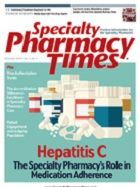Publication
Article
Specialty Pharmacy Times
Adding to Your Toolbox
Knowledge of the specialty drug pipeline is essential in planning for your practice.
Knowledge of the specialty drug pipeline is essential in planning for your practice.
Before one starts building a house, it’s important to have the right materials and tools to get the job done. Specialty Pharmacy Times works hard at providing new tools and resources to help pharmacists be successful in their practice and business.
Our December edition of Specialty Pharmacy Times gives us an opportunity to reflect on many of the developments of 2014 while looking forward to 2015. It has been said that history is the best predictor of the future, and we have created a good deal of history in 2014. So much of what we do in specialty is related to new product development, improvements to existing therapies, and treatment solutions for disease states that were previously untreatable.
Key 2014 Approvals
One key reason we focus on new products and the pipeline is to allow our diverse readership to prepare for the future. There was a modest handful of pure specialty approvals in 2014 including: (1) Otezla (apremilast), indicated for the treatment of patients with moderate to severe plaque psoriasis who are candidates for phototherapy or systemic therapy; (2) Imbruvica (ibrutinib), indicated for the treatment of chronic lymphocytic leukemia and mantle cell lymphoma; and (3) Sovaldi (sofosbuvir), indicated for the treatment of chronic hepatitis C infection as a component of a combination antiviral treatment regimen.
Each of the above products took a different approach to its specialty pharmacy solution. I think we can learn from each of these examples and continue to monitor their progress. All 3 products are oral solids and, by and large, fall into the drug benefit payer space. Each is for a complex disease and requires the type of patient care that one would expect from a specialty pharmacy. The cost of therapy for these products is of the category that one would expect to see in specialty. What is interesting is that each of these products took a different approach to the marketplace.
One company took a very wide approach, with their products stocking in nearly all wholesalers and distributors with few restrictions as to the access a pharmacy may have in purchasing and dispensing the product, offering full open access.
Another company took the approach of establishing on their website a network of over 40 specialty pharmacies supported by a hub. In this model, the physician is provided a list of pharmacies with fax numbers and a detailed order form with patient and prescribing information. The physician fills out the form and faxes it to one of these 40 pharmacies.
The final example has the physician directly contact the hub, who then coordinates the benefits investigation and directs the prescription to one of 5 specialty pharmacies.
Frankly, the only common thread these products have is that specialty pharmacy has stepped up to the plate and become the key methodology through which the patient receives these products.
What’s in the Pipeline for 2015?
In this month’s Specialty Pharmacy Times, Aimee Tharaldson, PharmD, as she did last year, has generously provided our readers a specialty pipeline report. There are a number of potential specialty candidates on the list that specialty pharmacists should be reviewing and thinking about if they may want to have access to those products. A quick disclaimer: just because a product is in the pipeline report does not mean it will be approved. I often describe the approval process as being “fickle,” and speculative at best. In short, there are no guarantees a product will get approved. It’s just the nature of the business and the review process: complex disease states make breakthrough therapy approval a challenge. If you are a specialty pharmacy you must persevere in creating specialty solutions if you want a shot at access.
There are new potential therapies in 2015 for a number of disease states such as cancer, pulmonary fibrosis, hepatitis C, and for the first time, high cholesterol. Some of the products discussed in the pipeline article include:
- Pfizer’s palbociclib, a novel oral medication that selectively inhibits cyclin dependent kinases 4 and 6
- Amgen’s evolocumab, a proprotein convertase subtilisin kexin type 9 (PCSK9) inhibitor pending approval for the treatment of patients with high cholesterol
- Genentech’s Esbriet (pirfenidone) and Boehringer Ingelheim’s Ofev (nintedanib), recently approved breakthrough therapies approved to treat idiopathic pulmonary fibrosis, a progressive disease in which fibrosis or scarring in the lungs causes shortness of breath and a decrease in lung function and exercise capacity.
Each of these products presents potential opportunities with specialty pharmacy, and requires a unique approach. Each serves a different market, with great variability in the size of the potential patient population. One, evolocumab, will likely be available in a self-injectable dosage form, also well suited for specialty pharmacy. As is the case with many self-injectable products, specialty pharmacies may engage the resources of a nursing network in order to train the patients on self-administration, so please consider all the facets of a product: Call it “look before you leap.”
There will be challenges for specialty pharmacy as payers review new breakthrough therapies and establish pathways toward reimbursement. Many manufacturers choose to use a hub service provider as the first line in securing payer reimbursement, while others in a more limited pharmacy network may choose to have the specialty pharmacy manage the process.
More Limited Networks
If a manufacturer is choosing to create a restricted or limited network on specialty pharmacies, depending on their criteria, a pharmacy may or may not be selected to be in their network. So much depends upon the characteristics of the product in determining the distribution plan. The size of the patient population is often a key driver in selecting the number of pharmacies in a specialty pharmacy network. The challenge for your pharmacy is that you must compete on services and, therefore, access. Specialty pharmacies are often judged by manufacturers on their ability to obtain coverage for new and expensive products.
Can Your Pharmacy Play?
Nearly every edition of Specialty Pharmacy Times has a list of potential approvals and their general status; these are in our journal as a road map for our readers. Stakeholders such as Express Scripts, Caremark, Catamaran, Walgreens Specialty, and others frequently publish lists of trends that include future products. The point is, if you want to win, you need to work hard to stay ahead of the pack. Hopefully, you’ve included Specialty Pharmacy Times in your toolbox. SPT
Specialty Pharmacy Times
is THE journal fully committed to setting the publication standard through peer-written and reviewed articles focused on the “real world” of specialty pharmacy practice. We invite you to enjoy this issue and pass it on! We welcome your feedback on this topic and on any topics you would like us to cover in future editions of Specialty Pharmacy Times. Please reach out to me at [email protected]. And we also encourage you and your colleagues to subscribe to this unique journal, receive the e-Newsletter, and sign up for the free App by logging on to www.specialtypharmacytimes.com.
Dan Steiber, RPh, is a principal of D2 Pharma Consulting LLC (d2rx.com) and is responsible for commercial operations, trade-supply chain strategy development including 3PL selection, regulatory oversight, and “operationalizing” organizations. He has served in several senior positions in pharmacy, distribution, and industry over the course of his 40-year career. Dan is a licensed pharmacist in Texas, Washington, California, and Pennsylvania. He is affiliated with several professional associations and publications and is a frequent speaker on behalf of many professional organizations. He graduated from Washington State University College of Pharmacy and has participated in a variety of postgraduate programs in law and business development/marketing at Harvard University and Northwestern University. Dan currently resides in Highland Village, Texas.







